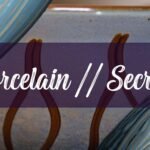Porcelain is celebrated for its delicate beauty and surprising strength, a ceramic material admired for its translucence and fine texture. At the heart of this remarkable creation lies a specific type of clay: kaolin. The unique properties of kaolin, along with its careful preparation and combination with other materials, are what give porcelain its distinctive characteristics.
Kaolin: The Essence of Porcelain
Kaolin, also known as china clay, is a naturally occurring mineral rich in kaolinite. This clay is found in various countries around the world and is the primary ingredient in porcelain. What sets kaolin apart from other clays is its purity, whiteness, and ability to withstand high firing temperatures. These qualities are essential for achieving the desired translucency and strength in the final porcelain product. A true porcelain derives all its plasticity from kaolin.
The composition of kaolin plays a crucial role in porcelain production. Its fine particle size contributes to the smooth and fine-grained texture of porcelain. During the high-temperature firing process, the kaolin clay particles vitrify, fusing together to create a dense, non-porous material. This vitrification is what gives porcelain its strength and translucency. However, kaolins often have limited plasticity, which can make them challenging to work with, especially for throwing or modeling. To improve workability, potters often mix kaolin with other materials like ball clay, silica, and feldspar. You can improve plasticity through mastering wedging techniques.
Compared to other types of clay, kaolin is unique in its mineral composition and behavior during firing. Ball clay, for example, is much finer and more plastic than kaolin, but it also contains more iron oxide, which can affect the fired whiteness of the porcelain. Bentonite is even finer than ball clay and incredibly plastic; adding just a small amount can significantly improve working properties. However, like ball clay, bentonite can also impact the whiteness of the final product. The purest kaolins and ball clays are often the least plastic, making them suitable for casting porcelains where whiteness is more critical than workability. Ultimately, the choice of clay and additives depends on the desired properties of the finished porcelain piece.
Beyond Kaolin: Essential Additives and Firing
While kaolin forms the foundation of porcelain, other materials are essential for achieving its unique properties. Silica, typically in the form of quartz, adds strength to the body once fired. Feldspar acts as a flux, lowering the melting point of the mixture and allowing it to vitrify at a lower temperature. These additional components are carefully balanced to create a porcelain body that is both workable and capable of achieving the desired translucency and strength. The exact proportions of kaolin, silica, and feldspar vary depending on the specific type of porcelain being produced.
The firing process is where the magic truly happens, transforming the raw materials into the finished porcelain. Porcelain is typically fired at high temperatures, ranging from Cone 10 to Cone 13, which translates to approximately 2381°F to 2455°F (1305°C to 1346°C). These ultra-hot temperatures ensure that the porcelain body becomes fully vitrified and glass-like, giving it its characteristic translucence and durability. The high firing temperature causes the kaolin clay particles to fuse together, creating a dense and non-porous material.
During firing, it’s crucial to manage the cooling process carefully. Porcelain contains silica, and critical cooling periods around 1063°F (573°C) and 439°F (226°C) are essential for preventing cracking. If the cooling is too rapid, the tension buildup can weaken the body, leading to breakage, sometimes even weeks after the piece has cooled. Proper kiln control and a slow, even cooling process are vital for producing high-quality porcelain. You can maintain proper kiln control with regular kiln care.
Variations in Porcelain: Hard-Paste, Soft-Paste, and Bone China
While kaolin is the common thread, different types of porcelain exist, each with its own unique composition and characteristics. The three main categories are hard-paste, soft-paste, and bone china. Hard-paste porcelain, invented in China, is considered the original and most durable form. It is composed primarily of kaolin, feldspar, and quartz and fired at very high temperatures.
Soft-paste porcelain emerged from early European attempts to replicate Chinese porcelain. These formulations typically involved mixtures of clay and frit, with ingredients like soapstone and lime. Soft-paste porcelains are fired at lower temperatures than hard-paste, resulting in a less hard and durable product.
Bone china, developed in England, is unique for its inclusion of bone ash, which provides extra strength and translucency. The typical composition of bone china is two parts bone ash, one part kaolin, and one part china stone or feldspar. Bone china is fired at a slightly lower temperature than hard-paste porcelain, resulting in its elegant, milky transparency. Each type of porcelain offers a distinct aesthetic and set of properties, making them suitable for different applications.
Defects and Particle Size
Like any ceramic process, porcelain production is susceptible to defects. Cracking, foaming, pinholes, and deformation are among the common issues that can arise. These defects can be caused by a variety of factors, including improper moisture levels, uneven thickness, rapid heating or cooling, and impurities in the materials. Careful attention to each stage of the process, from raw material preparation to firing and cooling, is essential for minimizing defects and ensuring high-quality porcelain.
Particle size distribution also plays a crucial role in the properties of porcelain. A wide distribution of particle sizes in the clay can lead to higher density and strength in the dried product. When particles are all of similar sizes, the resulting matrix is less dense. Industrial manufacturers often process materials to guarantee defect-free glazed surfaces. Manipulating particle size and distribution can also improve particle packing, increase homogeneity, and enhance mechanical properties. By carefully controlling particle size, potters can optimize the workability, density, and final quality of their porcelain creations.





